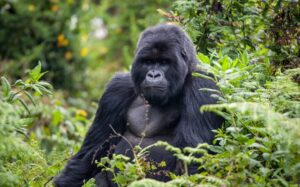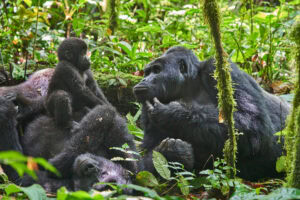Choosing between Rwanda and Uganda for gorilla trekking depends on your travel style and preferences, as each destination offers exceptional mountain gorilla viewing. This handy safari guide comparison should help you weigh your options based on our first-hand gorilla trekking experience.
If affordability and a broader wildlife safari are key, Uganda might be ideal. Rwanda might be the better fit if your goals include a luxurious stay, an easier trek, and maximising gorilla viewing. Let’s dig into some specifics about these endangered primates and each destination’s unique attributes to help you decide.
Endangered Mountain Gorillas
There are only three countries in the world where wild gorillas can be seen: Rwanda, Uganda, and Congo. No mountain gorillas can be seen in captivity as they cannot survive outside their natural habitat, making an African gorilla safari an incredibly special experience.
The early 1990s conflict in Rwanda and subsequent civil unrest in the Democratic Republic of Congo significantly impacted the Virunga Mountains region, home to over half of the world’s mountain gorilla population. The region saw a surge of refugees into the area, which escalated poaching activities and destroyed large parts of their habitats.
Timeline of Mountain Gorilla Population Recovery
The conservation success story of mountain gorillas, particularly in Rwanda, can be traced back to gorilla trekking permit requirements. These permits are a significant source of ecotourism revenue, priced at $1,500 per person in Rwanda and $800 in Uganda, and have had a direct funding impact on conservation efforts in the region.
- 1981: Mountain gorillas were on the brink of extinction, with only about 242 individuals left in the wild.
- 2010: The population increased to an estimated 480 gorillas in the Virunga Massif, which includes three national parks: Mgahinga Gorilla National Park in Uganda, Volcanoes National Park in Rwanda, and Virunga National Park in the Democratic Republic of Congo.
- 2018: A further census reported an encouraging increase to over 600 individuals in the Virunga Massif, bringing the global total of mountain gorillas to above 1,000 when combined with those in Uganda’s Bwindi Impenetrable National Park. This marked the first time in decades that the mountain gorilla population had surpassed 1,000 individuals.
Conservation Strategies
The International Union for Conservation of Nature (IUCN) updated the status of mountain gorillas from “Critically Endangered” to “Endangered” in 2018, reflecting the positive impact of sustained conservation efforts. These include:
- Anti-Poaching Measures: Establishing anti-poaching patrols and strict law enforcement has significantly reduced threats to gorillas from human activities.
- Veterinary Care: Programs like the Gorilla Doctors provide essential medical care to sick and injured gorillas, ensuring their survival.
- Community Engagement: Conservation efforts have increasingly involved local communities, providing them with sustainable alternatives to traditional practices that might harm the environment, such as poaching or deforestation.

Rwanda: The Luxe Trek
Rwanda is one of the most accessible and regulated gorilla trekking experiences globally, making it a top destination for those looking to witness these magnificent creatures up close while contributing to their conservation.
Where to See Gorillas in Rwanda
In Rwanda, the prime destination to see mountain gorillas is the Volcanoes National Park (Parc National des Volcans) in the northwestern region. The park is part of the larger Virunga Conservation Area, which spans parts of Uganda and the Democratic Republic of Congo.
The Gorilla Trekking Experience
This is for the luxury seeker and time-constrained traveller. Rwanda shines with its high-end lodges, ease of access, and the potential for shorter treks. It’s ideal for those looking for a luxurious, time-efficient adventure. Rwanda positions itself as a premium, eco-conscious mountain gorilla destination. Permits cost $1,500 (2024 pricing), contributing to conservation efforts and community development.
Best Time to Visit
Gorilla trekking can be done year-round, but the best times are during the dry seasons, from June to September and December to February, when the trails are less muddy and the hiking conditions are more favourable.
Preparation
Trekking can be physically demanding due to the uneven and sometimes steep terrain. You should be in good physical condition and bring appropriate gear such as hiking boots, rain jackets, and plenty of water.

Uganda: The Wild Explorer’s Choice
Responsible travel practices are intertwined with Uganda’s stunning natural beauty and rich cultural heritage.
Where to See Mountain Gorillas in Uganda
Uganda offers gorilla trekking in two locations:
Bwindi Impenetrable National Park
Home to nearly half of the world’s mountain gorillas, this UNESCO World Heritage Site offers intimate trekking experiences through dense, ancient forests to its larger, habituated gorilla families.
Mgahinga Gorilla National Park
This park is part of the Virunga Conservation Area and offers gorilla trekking, encounters with golden monkeys, and traditional Batwa cultural experiences.
The Gorilla Trekking Experience
Uganda suits the typical wilderness explorer. The country’s more affordable permits combine with the allure of a rugged, immersive trekking experience. Uganda’s permits are generally less expensive, $800 (2025/2026 pricing), making it more affordable for travellers while contributing significantly to conservation efforts.
It’s perfect for those who want to dive deep into the heart of Africa’s jungles and are willing to take on a challenge. Beyond gorillas, Uganda offers a broader range of wildlife and activities, such as chimpanzee trekking in Kibale National Park and classic big game safaris in Queen Elizabeth National Park.
Best Times to Visit
The dry seasons offer the best conditions for gorilla trekking from June to August and December to February. Uganda is a year-round bird-watching destination, with over 1,000 bird species and wildlife viewing in national parks.
Preparation
Noting Uganda’s more rigorous trekking experience, you should ensure you’re in good physical condition. Adhere to guidelines during gorilla and chimpanzee treks to minimise impact on these fragile ecosystems. Always follow recommended health precautions, including vaccinations and malaria prophylaxis, and stay informed about local safety guidelines.
Both countries offer unique experiences that go beyond mere comparison. Your choice hinges on your budget, the level of adventure you seek, and the broader itinerary you envision for your safari. Whichever path you choose, let Discover Africa help you plan an unforgettable encounter with the majestic mountain gorillas.
Author: Alice Lombard
Published:
Last Update:
Part of the Mountain Gorilla Trekking Collection